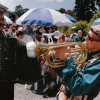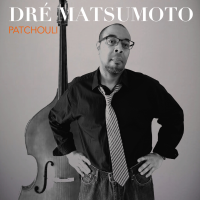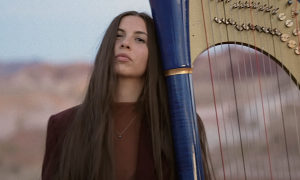Home » Jazz Articles » Interview » Kelvin Roy at The Loaded Hog
Kelvin Roy at The Loaded Hog
I feel that participating in a live performance, whether as a performer or part of the audience, is the most human thing we can do.
 Kelvin Roy is a North America émigré who lives in New Zealand. He has released three compact discs to date and his latest is Around the World of Music Live at The Loaded Hog with the BlueStars. Aside from singing, composing and arranging his own material, he also plays the bass trumpet. Herein a conversation concerning his latest project and other related matters to his career and music in New Zealand:
Kelvin Roy is a North America émigré who lives in New Zealand. He has released three compact discs to date and his latest is Around the World of Music Live at The Loaded Hog with the BlueStars. Aside from singing, composing and arranging his own material, he also plays the bass trumpet. Herein a conversation concerning his latest project and other related matters to his career and music in New Zealand:
AAJ: Would you please describe your relationship with this recording’s venue, i.e., The Loaded Hog? How important has it been for your career?
KR: I played there with my BlueStars band for three and a half years –mostly Sunday afternoons, plus some nights and special events. Considering the growing diversity in entertainment for some years now –and resulting competition for that dollar– performing at The Loaded Hog was very important for my career. Good quality jobs have been harder and harder to come by over the years and to have a regular gig at a higher caliber venue is hard to underestimate. Therefore, this was a place where the band was able to play together regularly in a positive environment. In addition, it contributed to the recording in a substantial way.
AAJ: What kind of audience is one liable to find there during your gigs? Are they mostly young? Old? Is it an ethnically diverse one?
KR: Having done many wine and music festivals and private functions, we’re certainly aimed at a diverse cross-section of people. Moreover, you’d have to say the audience reflects the mutual appeal of us performing at the Loaded Hog. There is a wide range of people young to old, singles, couples, families and tourists from many places in the world. Therefore, you would have to say cosmopolitan.
AAJ: What is their social status?
KR: Being an up-market pub and restaurant, on a grand scale usually only seen in America –with a capacity of about 1200– most people would be reasonably well to do, I guess. Being, however, on the waterfront in Auckland, where they held the America's Cup Races, you get all kinds of people from all places and occupations.
AAJ: Is there ever any dancing during the gigs? How loaded can one get at the Loaded Hog?
KR: My feeling has always been that if people dance, then we’re connecting with them and doing our job well. We got people dancing there, mostly of an impromptu nature, which is really, what music is all about –getting emotional reactions from people. If you want to talk about jazz, one of my greatest joys has been observing people in the audience who are not into it get up and start jumping around! That is fulfilling. Many people get loaded at the Loaded Hog. There must be something in a name! The good thing is the vibe is positive and I never witnessed any ill will or aggressive behavior. It’s a pleasant environment there on the waterfront, surrounded by boats.
AAJ: What was the atmosphere during the recording?
KR: The atmosphere was relaxed. Jazz is performance music and, having played together quite a lot over the years, we were at ease. There was some exuberance too and I’m pretty pleased with the result.
AAJ: What are Kelvin Roy & BlueStars all about?
KR: I believe in entertaining to enlighten and have always been interested in making people happy. We’re about art. In addition, I guess through practice of the art and the craft of music you distill your life down to its essence. If this essence appeals to enough people then it becomes entertainment as well.
AAJ: How do you guys relate to each other on stage?
KR: One great thing about New Zealand is the extraordinary musicians I’ve been able to work with. Some are expatriate Americans, many are Kiwis, and others are from England or beyond. The BlueStars band has always been made up of competent musicians, whatever the configuration at the time. Moreover, the rapport is good and often well humored. I know that often comes out in the music, too. Therefore, the relationship on stage is one of good communication and humor.
AAJ: What are some of the respective strengths of the BlueStars?
KR: As a leader, you need to give clear cues and directions to people about what is to come. It is crucial to have people who can follow a lead and know how to end a song for example. Dave Lines, my keyboardist, is one such person. Guitarist Nigel Gavin, who appears on many of the studio recordings, is another. These are first class musicians. Song endings are my strength in this group. I know, after all, that the ending of a song is what people remember the most. These musicians all know their art and craft very well. Many people have remarked to me that the Latin beats on the Live album are very authentic and true to form. Therefore, the drummer Trevor Thwaites takes the credit here.
AAJ: Is there any rhyme or reason to the recording’s repertoire?
KR: One critic said, “the title is a mouthful, but that’s what it is.” I wanted to capture my travels around the world of music. While there are other tunes I would have liked to include, I think this is a good representation. We start in New York à la Sinatra, then go to Chicago for some blues, down the Mississippi for some more, into the Caribbean for reggae flavors and Cuba for the Afro-Cuban thing, then down-under for some South Pacific jazz, and back up to America for some foot stompin’ blues. Horace Greeley said, “Go west, young man...” I’m still going. I just took a circuitous route and went farther than he perhaps ever imagined!
AAJ: How did you meet Latin music and what attracts you towards it?
KR: While there isn't a lot of Latin in my recorded work, we have done a great deal in performance over the years. It started in Los Angeles when I played in a band with a Latino rhythm section and we did some of that repertoire. Songs like “Rosa María.” I found Cumbias very popular in that part of the country, I guess because they are also popular in Mexico, even though that style came from Colombia. Later in New Zealand, I formed a Latin band of my own and we did a range of salsas, merengues, sambas, and bossas. Then, we developed the repertoire further with the BlueStars band, which included quite a bit of Cuban music, as one might have noted on the album. I think many of the recent Cuban music recordings were long overdue, like the ones instigated by Ry Cooder.
I was in Miami in 1998 for the MIDEM music trade fair. The showcases I saw and heard there were the best I’ve ever experienced. I believe it was the first US performance by Chucho Valdés with about a twelve-piece band, plus La Charanga Rubalcaba, of about 14 members. Then to top it off, Compay Segundo and Rubén González were there with their groups. It was sort of a Buena Vista Social Club (BVSC). This was a concert before the one they filmed in New York for the BVSC movie eventually released, I think. They were all on one bill. It was incredible! What’s even more incredible is that there was a bomb scare near the end of the show in the Miami Convention Center, due to the expatriate Cuban community's objection to Castro supporter Chucho Valdés’ performance. Then, the next night they did the whole show again! It was like lightening striking twice in the same place!
What attracts me so much to Latin music is what attracts me to jazz and quite a bit of the music we still listen to today. That is the polyrhythms and certain rhythms –the strong African ones– that survived the trip to the Americas. I have an affinity for the Afro-Cuban sound and beats that we hear in so much Latin music. I also think there’s an independent sense of melody often times in Latin music similar to that of jazz and other African-derived or cross-pollinated music. I also am inspired by some of the percussion instruments. I’ve owned the same güiro for 20 years and I’ve got some pre-Columbian Aztec percussion instruments, like the Ayoyote –a seed pod rattle– that are really fascinating. It sounds like applause, so if people seem a bit hesitant I can always shake it myself to drum up a bit of support! Moreover, sometimes, you hear a performance of a particular song that inspires you. A good example of this is the classic song “Bésame Mucho.” I never quite liked it that much until I heard Spanish artist Sammy Goz do a Cha Cha Cha version of it and I was sold!

AAJ: How popular is Latin music in New Zealand?
KR: Latin music was quite popular in New Zealand in the 1990’s. In 1992, we played the opening of a large Latin venue. A lot of our dance repertoire is Latin and it has worked well for us in terms of crowd acceptance and appreciation all the way through. It gets people dancing around the tables, or at least under them. There were many Chilean immigrants to New Zealand in the 1980’s and 90’s and this certainly provided some of the impetus for the practice and popularity of the music.
AAJ: Any comments on the live musical scene in New Zealand?
KR: I think like many places in the world, live performance is on the way down. Like music itself, however, it will cycle back. Just now, I think we're in the middle of this gigantic polyrhythmic reverberation. I feel that participating in a live performance, whether as a performer or part of the audience, is the most human thing we can do. Therefore, it might be down, but it will never be out. I moved to Australia last year for a change. With gambling and all the home entertainment options, the live musical scene is getting the squeeze. However, as long as there are people who love to do it and put their music out there it will never die.
AAJ: Would you please relay any comments about famous people met, special occasions, or highlights of your career in New Zealand?
KR: Playing during the America’s Cup was exciting. There were so many people, you couldn't move! Since I like wine, doing the wine festivals was always a favorite one and there are some good jazz festivals there like Waiheke Island of Jazz –started by New Orleans pianist David Paquette– and the National Jazz Festival. We really made an impact at these events. In addition, I’d have to say there was a reasonably good market for jazz during most of the time I was in New Zealand. For this I am Thankful.
Website: http://www.kelvinroy.com .
Tags
PREVIOUS / NEXT
Support All About Jazz
 All About Jazz has been a pillar of jazz since 1995, championing it as an art form and, more importantly, supporting the musicians who make it. Our enduring commitment has made "AAJ" one of the most culturally important websites of its kind, read by hundreds of thousands of fans, musicians and industry figures every month.
All About Jazz has been a pillar of jazz since 1995, championing it as an art form and, more importantly, supporting the musicians who make it. Our enduring commitment has made "AAJ" one of the most culturally important websites of its kind, read by hundreds of thousands of fans, musicians and industry figures every month.


























